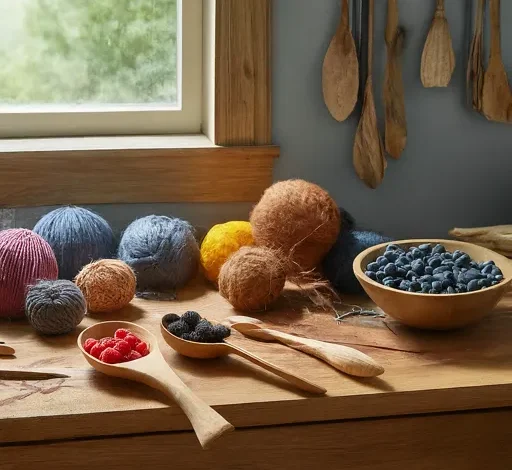The Artisanal Approach: Handmade and Earth-Friendly Living

Have you ever held a handmade item and felt a special connection to it? There’s something magical about objects crafted with care and skill. This is the essence of the artisanal approach to living – a lifestyle that values quality, sustainability, and personal touch.
In recent years, there’s been a surge in interest for handmade and sustainable products. People are turning away from mass-produced items and embracing a more mindful way of living. This shift isn’t just a trend; it’s a movement towards a healthier planet and a more fulfilling life.
Adopting an artisanal lifestyle offers numerous benefits:
- Reduced environmental impact
- Support for local economies
- Higher quality, longer-lasting products
- Unique, personalized possessions
By choosing handmade and earth-friendly options, we can make a real difference in our lives and the world around us.
The Rise of Artisanal Living
Why Handmade is Making a Comeback
The resurgence of handmade products isn’t just about nostalgia. It’s a response to our fast-paced, disposable culture. People are craving authenticity and connection in a world of mass production.
Quality over quantity is the mantra of artisanal living. When we buy fewer, better-made items, we:
- Reduce waste
- Save money in the long run
- Enjoy our possessions more
Artisanal living also helps us connect more deeply with our belongings and the environment. When we know the story behind an item – who made it, where it came from – we’re more likely to value and care for it.
The Impact of Choosing Handmade
Opting for handmade products has far-reaching effects:
- Environmental benefits: Artisanal production often uses less energy and creates less waste than mass manufacturing.
- Economic impact: Buying handmade supports local artisans and keeps money in your community.
- Personal satisfaction: Owning unique, well-crafted items can bring joy and a sense of connection.
- Skill preservation: Choosing handmade helps keep traditional crafts and skills alive.
By embracing artisanal living, we’re not just making a choice about what we buy. We’re making a statement about what we value and the kind of world we want to live in.
Benefits of Handmade Products
When you choose handmade products, you’re not just buying an item – you’re investing in quality, uniqueness, and sustainability. Let’s explore the key advantages:
Superior Quality and Durability
- Crafted with attention to detail
- Made from higher-quality materials
- Built to last, reducing the need for frequent replacements
Unique and Personalized
- Each item is one-of-a-kind
- Often customizable to your preferences
- Reflects the artisan’s individual style and creativity
Supports Local Artisans and Economies
- Provides income for skilled craftspeople
- Keeps money circulating in local communities
- Preserves traditional skills and techniques
Reduced Environmental Impact
- Often uses sustainable materials and production methods
- Less energy-intensive than mass production
- Typically involves less packaging and shipping
By choosing handmade, you’re not just getting a product – you’re supporting a more sustainable and personal way of consuming.
Earth-Friendly Materials in Artisanal Crafts
Artisanal crafts often go hand-in-hand with eco-friendly materials. This combination creates products that are not only beautiful but also kind to our planet.
Common Sustainable Materials in Artisanal Crafts:
- Organic cotton
- Reclaimed wood
- Recycled metals
- Natural dyes
- Bamboo
- Hemp
- Upcycled fabrics
Spotlight on Eco-Friendly Materials
Organic Cotton: Unlike conventional cotton, organic cotton is grown without harmful pesticides or synthetic fertilizers. It’s better for the environment, the farmers, and your skin.
Reclaimed Wood: This wood gets a second life, preventing deforestation and reducing waste. Each piece tells a unique story through its grain and patina.
Natural Dyes: Made from plants, minerals, and sometimes insects, natural dyes create beautiful colors without the toxic chemicals found in synthetic dyes.
The Impact of Choosing Sustainable Materials
When artisans use eco-friendly materials, they:
- Reduce pollution and chemical runoff
- Conserve natural resources
- Minimize waste by using recycled or upcycled materials
- Promote biodiversity by supporting sustainable farming practices
By choosing products made with these materials, you’re supporting a healthier planet and encouraging more sustainable production methods.
DIY: Embracing the Artisanal Spirit at Home
You don’t need to be a master craftsperson to enjoy the benefits of artisanal living. Creating your own handmade items can be a rewarding and accessible way to embrace this lifestyle.
Simple Projects to Start With:
- Homemade candles: Use natural waxes and essential oils for eco-friendly ambiance.
- Knitted or crocheted accessories: Create scarves, hats, or blankets with organic yarns.
- Natural beauty products: Mix your own face masks or body scrubs with kitchen ingredients.
- Upcycled furniture: Give old pieces new life with a fresh coat of non-toxic paint.
- Handmade greeting cards: Craft personalized cards using recycled paper and natural inks.
Tips for Sourcing Eco-Friendly Materials:
- Shop local: Visit craft stores or farmers’ markets for locally-sourced materials.
- Look online: Many websites specialize in eco-friendly craft supplies.
- Upcycle: Use items you already have at home in creative ways.
- Research: Learn about the environmental impact of different materials before buying.
The satisfaction of creating your own handmade items is unmatched. It connects you to the artisanal process and gives you a deeper appreciation for handcrafted goods.
Artisanal Food and Beverages
The artisanal approach extends to what we eat and drink, embodied in the slow food movement.
The Slow Food Movement Principles:
- Good: High-quality, flavorful food
- Clean: Production that doesn’t harm the environment
- Fair: Accessible prices for consumers and fair conditions for producers
Benefits of Artisanal Food Production:
- Superior taste: Small-batch production often results in better flavor
- Healthier options: Usually contains fewer preservatives and artificial ingredients
- Supports local farmers: Keeps money in the local economy
- Preserves food heritage: Maintains traditional recipes and techniques
Incorporating Artisanal Foods into Your Diet:
- Visit local farmers’ markets
- Join a community-supported agriculture (CSA) program
- Try making your own bread, cheese, or preserves
- Seek out local, small-batch producers for items like coffee, chocolate, or beer
By choosing artisanal foods, you’re not just eating well – you’re supporting a more sustainable and equitable food system.
Sustainable Fashion and Accessories
Fast fashion has a huge environmental cost. Choosing artisanal and sustainable fashion is a powerful way to reduce your impact.
The Problem with Fast Fashion:
- Excessive water use and pollution
- High carbon emissions
- Poor working conditions in factories
- Encourages disposable clothing culture
Benefits of Artisanal and Sustainable Fashion:
- Higher quality: Lasts longer, reducing overall consumption
- Unique style: Stand out with one-of-a-kind pieces
- Ethical production: Better working conditions for artisans
- Reduced environmental impact: Uses sustainable materials and processes
Tips for Building an Eco-Friendly Wardrobe:
- Invest in quality: Choose well-made pieces that will last
- Shop secondhand: Give pre-loved items a new life
- Support ethical brands: Research companies’ sustainability practices
- Learn to mend: Extend the life of your clothes with basic repair skills
- Organize clothing swaps: Exchange items with friends for a free wardrobe refresh
Remember, the most sustainable garment is the one already in your closet. Loving and caring for what you have is the first step in sustainable fashion.
Home Decor and Furnishings
Incorporating handmade elements into your living space can create a warm, unique atmosphere that reflects your personality and values.
Upcycling and Repurposing Ideas:
- Turn old wooden pallets into shelving or coffee tables
- Create throw pillows from vintage fabrics
- Repurpose mason jars as candle holders or planters
- Transform an old ladder into a bookshelf
- Use reclaimed wood for picture frames
Balancing aesthetics with sustainability is key. Choose pieces that are both beautiful and eco-friendly to create a harmonious, earth-conscious home.
The Economic Impact of Artisanal Living
Choosing artisanal products has significant economic implications:
- Supports local economies: Money spent on local artisans tends to stay within the community.
- Promotes small businesses: Helps independent craftspeople thrive in a competitive market.
- Creates jobs: Artisanal production often requires more human labor than mass manufacturing.
While handmade items may have higher upfront costs, their quality and durability often lead to long-term savings. A well-made artisanal piece can last for years, reducing the need for frequent replacements.
Challenges of Artisanal Living
Embracing an artisanal lifestyle isn’t without its challenges:
- Higher initial costs: Handmade items often come with a higher price tag.
- Limited availability: Some products may be harder to find or have longer wait times.
- Time investment: DIY projects and sourcing artisanal goods can be time-consuming.
- Balancing with modern conveniences: It may not be practical to choose handmade for everything.
Despite these challenges, many find that the benefits of artisanal living outweigh the drawbacks.
Embracing Artisanal Living: Practical Tips
- Start small: Begin by incorporating one or two handmade items into your life.
- Prioritize: Choose areas where artisanal products will have the most impact for you.
- Connect with local artisans: Attend craft fairs or join online communities to discover local makers.
- Learn new skills: Take a class or watch online tutorials to create your own handmade items.
- Be patient: Building an artisanal lifestyle takes time. Enjoy the journey!
Conclusion
The artisanal approach to living offers a path to a more sustainable, meaningful, and personally satisfying lifestyle. By choosing handmade and earth-friendly products, we can:
- Reduce our environmental impact
- Support local economies and skilled artisans
- Surround ourselves with unique, high-quality items
- Connect more deeply with our possessions and the world around us
While there may be challenges, the benefits of artisanal living extend far beyond the individual. Each handmade purchase or DIY project is a step towards a more sustainable and conscious world.
We encourage you to take the first step in your artisanal journey today. Whether it’s buying a handmade item, starting a DIY project, or simply learning more about sustainable materials, every action counts.
Remember, the path to a more earth-friendly lifestyle is a journey, not a destination. Embrace the process, celebrate small changes, and enjoy the satisfaction of living more mindfully and sustainably.



